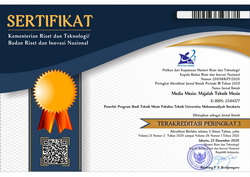APPLICATION OF TORQUE EXPANSION CHAMBER (TEC) AND NOZZLE ON EXHAUST MANIFOLD HONDA SUPRA X 125
Sanurya Putri Purbaningrum(1*), Ammar Fakhrurozi Nazih(2), Sartono Putro(3)(1) Politeknik STMI Jakarta
(2) Fakultas Teknik, Program Studi Teknik Mesin, Universitas Muhammadiyah Surakarta
(3) Fakultas Teknik, Program Studi Teknik Mesin, Universitas Muhammadiyah Surakarta
(*) Corresponding Author
Abstract
Gasoline motorcycles are a means of transportation that is currently the most in-demand by the people of Indonesia. Most of the youth are waiting for gasoline-fueled motorbikes with superior performance so many lovers from the automotive sector, researchers and industry make modifications to improve the performance of these vehicles. This study aims to improve the performance of the gasoline engine. The research method used is to modify the exhaust manifold on the combustion engine. Modifications are made by adding a Torque Expansion Chamber (TEC) 1 tube 2 channels and variations of nozzles 40, 50, and 60. The next step is to test torque, power, and specific fuel consumption. The results show that the use of 1 tube 2 channel TEC and variations of nozzles 40, 50, and 60 can increase torque, increase power and reduce specific fuel consumption. The highest torque of 9.94 Nm was obtained at 5500 rpm using 1 tube 2 channel TEC and 50 nozzle variations. The highest power of 8.03 HP was obtained at 6250 rpm using 1 tube 2 channel TEC and 50 nozzle variations. Minimum specific fuel consumption with a value of 0.14145 kg/kWh was obtained by using TEC 1 tube 2 channel and nozzle variation 40. Increasing torque by using modified TEC 1 tube 2 channel and nozzle variation 40, 50, and 60 is due to back pressure so that heat that comes out with the exhaust gases is not completely removed by the environment. The increase in power is caused because the power is directly proportional to the torque, while the decrease in specific fuel consumption is caused because the specific fuel consumption is inversely proportional to the power.
Keywords
Full Text:
PDFReferences
Umesh, K. S., Pravin, V. K., & Rajagopal, K. (2014). Experimental Investigation and CFD Analysis of Multi-Cylinder Four Stroke SI Engine Exhaust Manifold for Optimal Geometry to Reduce Back Pressure and to Improve Fuel Efficiency. International Journal of Automobile Engineering Research and Development, 4, 13, 20.
Bajpai, K., Chandrakar, A., Agrawal, A., & Shekhar, S. (2017). CFD analysis of exhaust manifold of SI engine and comparison of back pressure using alternative fuels. IOSR Journal of Mechanical and Civil Engineering (IOSR-JMCE), 14(1), 23-29.
Sanata, A. (2011). Pengaruh Diameter Pipa Saluran Gas Buang Tipe Straight Throw Muffler Terhadap Unjuk Kerja Motor Bensin Empat Langkah. Jurnal Rotor, 4(1), 32-39.
Magdas, V.B., Moldpvanu, D., Mastan, D.C. (2019). Intake and Exhaust Pipe Optimization for an internal Combustion Engine. IOP Conference Series: Material Science and Engineering
Sucahyoaji, 2014. Bajaj Exhaust TEC, teknologi knalpot meningkatkan torsi bawah tanpa mengorbankan torsi atas. [Online] Available at: https://kupasmotor.wordpress.com/2014/12/24/bajaj-exhaustec-teknologi-knalpot-meningkatkan-torsi-bawah-tanpa-mengorbankan-torsi-atas
Article Metrics
Abstract view(s): 724 time(s)PDF: 462 time(s)
Refbacks
- There are currently no refbacks.








